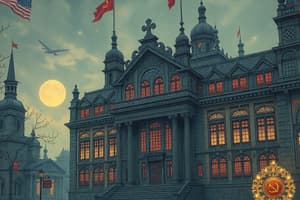Podcast
Questions and Answers
Which of the following best describes the primary ideological conflict that defined the Cold War?
Which of the following best describes the primary ideological conflict that defined the Cold War?
- An economic rivalry between nations adhering to free market principles and those espousing protectionist policies.
- A clash of civilizations rooted in historical animosities and cultural differences that had been simmering for centuries.
- A struggle between capitalist democracies advocating for individual freedoms and communist regimes promoting state control and suppression of dissent. (correct)
- A geopolitical competition centered on territorial expansion, with both sides seeking to acquire strategic bases and resources worldwide.
What was the main goal of the Marshall Plan, initiated by the United States after World War II?
What was the main goal of the Marshall Plan, initiated by the United States after World War II?
- To promote free trade agreements between the United States and its wartime allies.
- To provide humanitarian aid to countries devastated by the war, regardless of their political alignment.
- To establish military bases across Western Europe to counter Soviet expansion.
- To rebuild the economies of Western Europe and Japan to prevent the spread of communism. (correct)
In the context of the early Cold War, what was the significance of the Soviet Union's actions in Eastern Europe?
In the context of the early Cold War, what was the significance of the Soviet Union's actions in Eastern Europe?
- They demonstrated the USSR's commitment to international cooperation and peaceful coexistence.
- They aimed to foster democratic reforms and promote human rights in the region.
- They led to the establishment of satellite states under Soviet control, consolidating Soviet power and influence. (correct)
- They facilitated the integration of Eastern European economies into a global free market system.
Which of the following best describes the Truman administration's 'Containment Strategy'?
Which of the following best describes the Truman administration's 'Containment Strategy'?
How did the rise of Communist movements in Asia contribute to the Cold War tensions?
How did the rise of Communist movements in Asia contribute to the Cold War tensions?
What event in 1949 had a significant impact on the Cold War?
What event in 1949 had a significant impact on the Cold War?
Besides military assistance, how else did the Soviet Union support communist movements?
Besides military assistance, how else did the Soviet Union support communist movements?
What was the significance of the Berlin Blockade in 1948 during the Cold War?
What was the significance of the Berlin Blockade in 1948 during the Cold War?
Flashcards
The Cold War
The Cold War
Post-WWII global struggle between the U.S. and USSR, involving political, economic, and ideological conflict.
Joseph Stalin
Joseph Stalin
Dictator of the USSR who aimed to spread Marxism-Leninism worldwide.
Marxism-Leninism
Marxism-Leninism
An ideology aiming to subvert democracy, basic human rights, and freedom.
Marshall Plan
Marshall Plan
Signup and view all the flashcards
"Containment Strategy"
"Containment Strategy"
Signup and view all the flashcards
Ho Chi Minh
Ho Chi Minh
Signup and view all the flashcards
Mao Tse-tung
Mao Tse-tung
Signup and view all the flashcards
Kim Il Sung
Kim Il Sung
Signup and view all the flashcards
Study Notes
- Post-World War II, American Sailors confronted a new global threat to democracy, human rights, and freedom.
- The USSR, led by Joseph Stalin, aimed to consolidate wartime gains and promote Marxism-Leninism worldwide.
- Stalin undermined the independence of Eastern European nations like Poland and Czechoslovakia.
- The USSR exerted diplomatic and military pressure on Turkey and Iran.
- They supplied war materials to Greek Communists.
- In 1948, the Soviets caused a conflict with the U.S. and allies over Berlin.
- Communist movements in Asia received military aid from Moscow.
- Ho Chi Minh led Vietnamese Communists against the French in Indochina.
- Kim Il Sung fought Syngman Rhee for control of Korea.
- In 1949, Mao Tse-tung established the People's Republic of China.
- President Truman responded with economic, political, and military measures.
- The Marshall Plan provided billions to restore Western Europe and Japan's economies.
- The U.S. strengthened ties with anti-Communist governments.
- The Truman administration created a "Containment Strategy."
- This involved defending the Communist world with U.S. and allied armed forces.
- The United States Navy protected the "Containment Wall" throughout the Cold War.
Studying That Suits You
Use AI to generate personalized quizzes and flashcards to suit your learning preferences.




